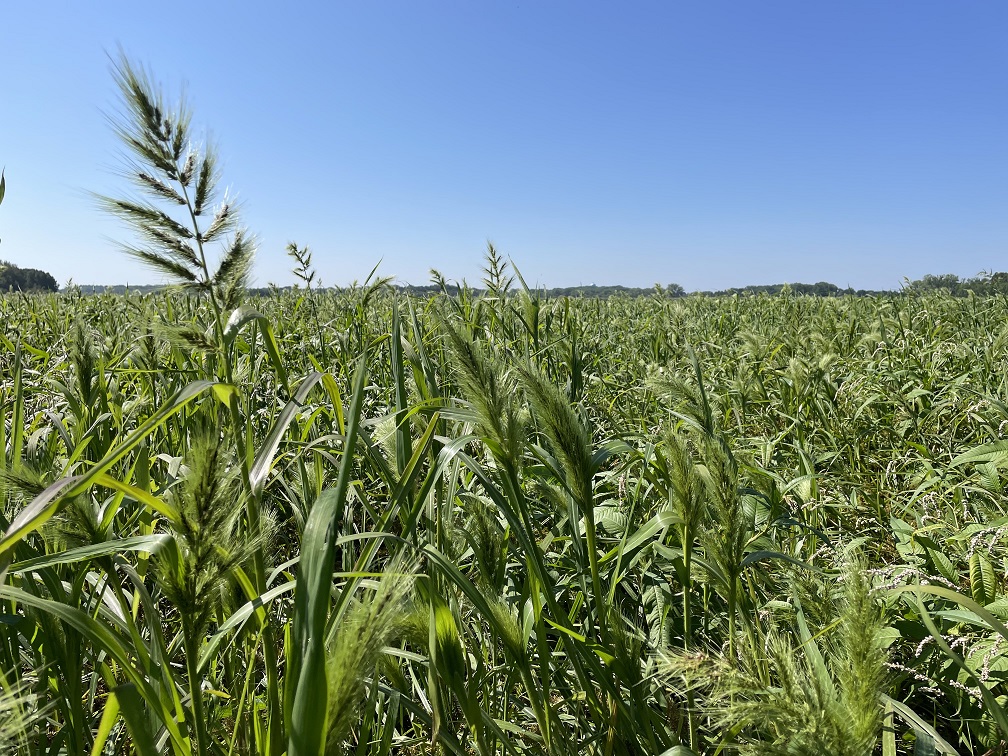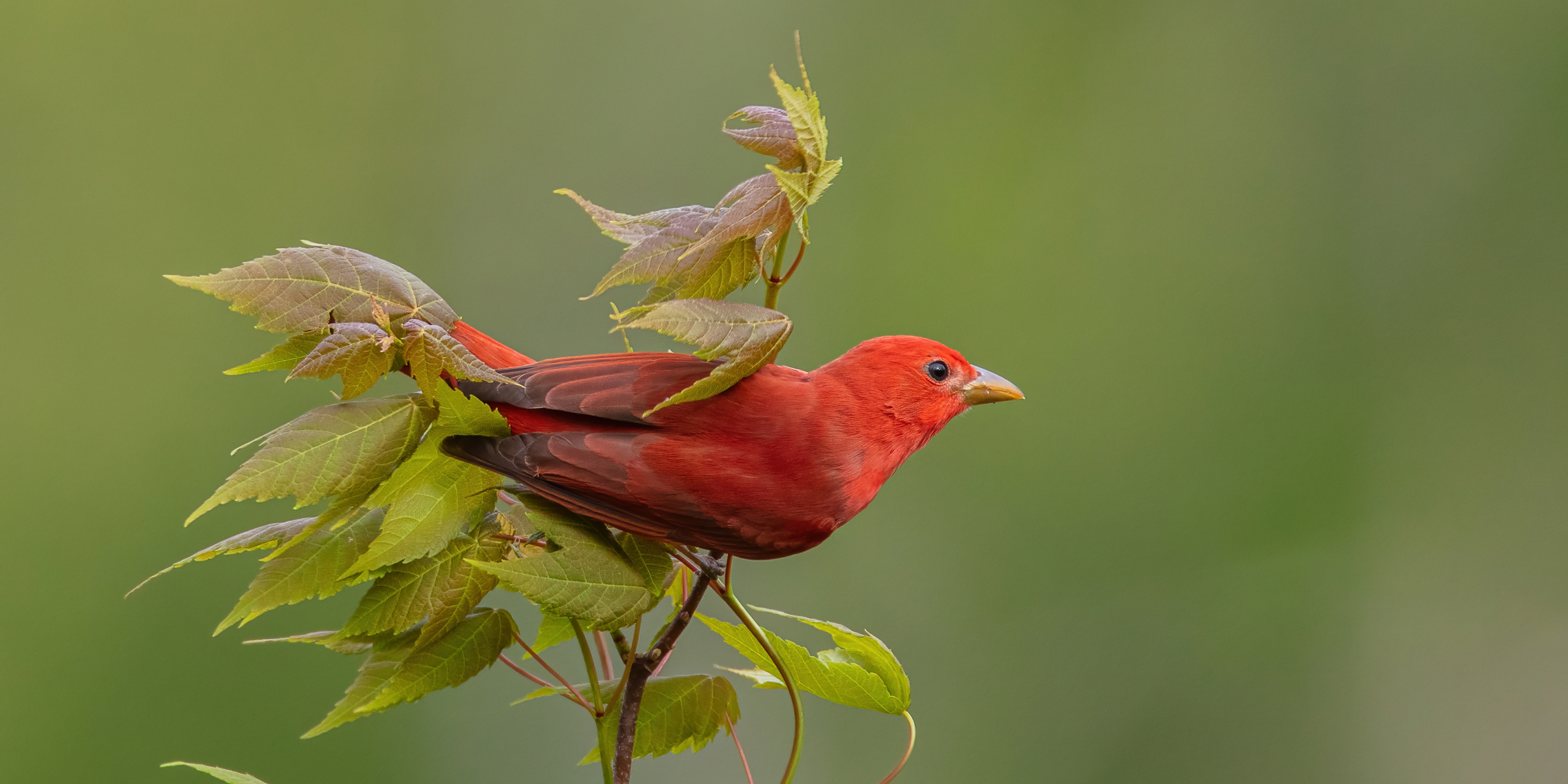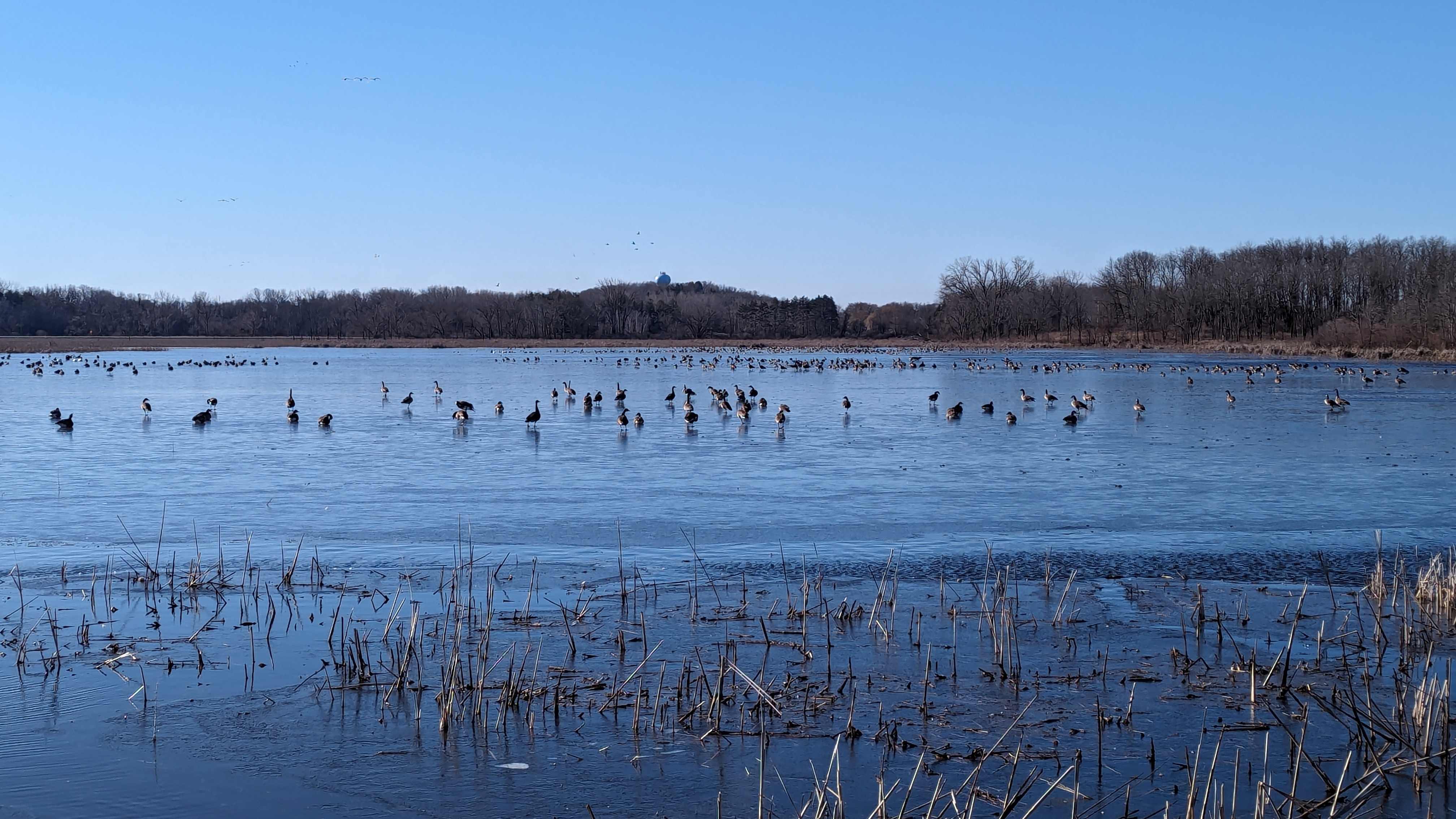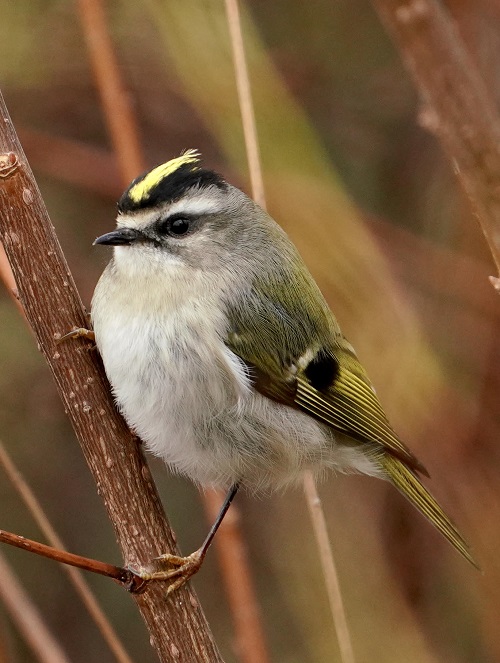Horicon Marsh is a 33,000 acre wetland dominated by cattail. It is designated as a Wetland of International Importance and Important Bird Area separated into both State Wildlife Area and National Wildlife Refuge.
Wetland productivity relies on a cycle of wet and dry conditions. Naturally, this wetland cycle tracks precipitation cycles. During drought, water levels decrease, soil becomes exposed to the air and new plants begin to grow from seed. Those plants are the base of the wetland food web that supports macroinvertebrates, painted turtles, blue-winged teal, trumpeter swans, Sandhill cranes, muskrats, river otters, beavers, and many more species. As conditions become wetter and water levels rise, wetland plants begin to die according to their tolerance for water depth and the duration of flooding. Decaying plants are readily consumed by macroinvertebrates which are themselves an important food for waterfowl and waterbirds. Eventually, flooding can become severe enough to eliminate all emergent plants and create a shallow lake. If the cycle is stabilized, either persistently dry or wet, productivity declines.
Stabilized water levels also favor the growth and spread of invasive narrowleaf and hybrid cattail. These species prefer relatively shallow and stable water about 1’ deep. Unfortunately, the vast majority of Horicon Marsh has an artificially stabilized hydrology and water depth ideally suited to invasive cattail. These plants produce a tremendous amount of vegetative growth, especially in nutrient-rich (nitrogen & phosphorous, specifically) environments like we have in this agriculture-dominated watershed. The cattail growth (up to 12 feet annually) accumulates year after year creating a mulch up to 18 inches thick that covers the native soil and prevents other plants from growing. Prior to the 1980s, Horicon had a diverse mixture of native wetland plants interspersed with surface water. As invasive cattail spread across and dominated the marsh, the suitability of the marsh for wetland wildlife was significantly degraded.
In the I-3 wetland we wanted to increase productivity by jumpstarting the wetland cycle using a drawdown (a simulated drought) followed by flooding and by trying a new strategy for control of invasive cattail. We also wanted to put I-3 into a different wetland phase than the adjacent Bachhuber, I-1, and I-2 wetlands. By staggering the wetland cycle across these neighboring wetlands, each phase would be represented, so that wildlife adapted to that phase could find suitable habitat. This management strategy would also provide examples of each wetland phase for education programs.
We began dewatering I-3 in mid-March of 2023. When water is drained from a wetland and the substrate is exposed to air, the sediment hardens and plants begin to grow. The species of plants that grow from the seedbank depends on soil moisture and temperature. Smartweeds are highly beneficial wetland plants for waterfowl because they provide large, energy-rich seeds and because they support many invertebrates which in turn are a critical food for wildlife because they provide protein, calcium, and lipids for feather molt, egg production, growth and energy for migration. Smartweeds germinate best early in the growing season when the soil temperature is cooler. In contrast, cattails germinate best on saturated mud in mid-summer when soil temperatures are hotter. By dewatering the wetland early, we attempted to favor more desirable plants. In fact, we saw distinct bands of different wetland plant species: smartweed at the highest elevations that were exposed earliest, then barnyard grass and nutsedge (also very desirable for wetland wildlife), and finally, at the lowest and wettest sites that were last to be exposed, we saw cattail seedlings.
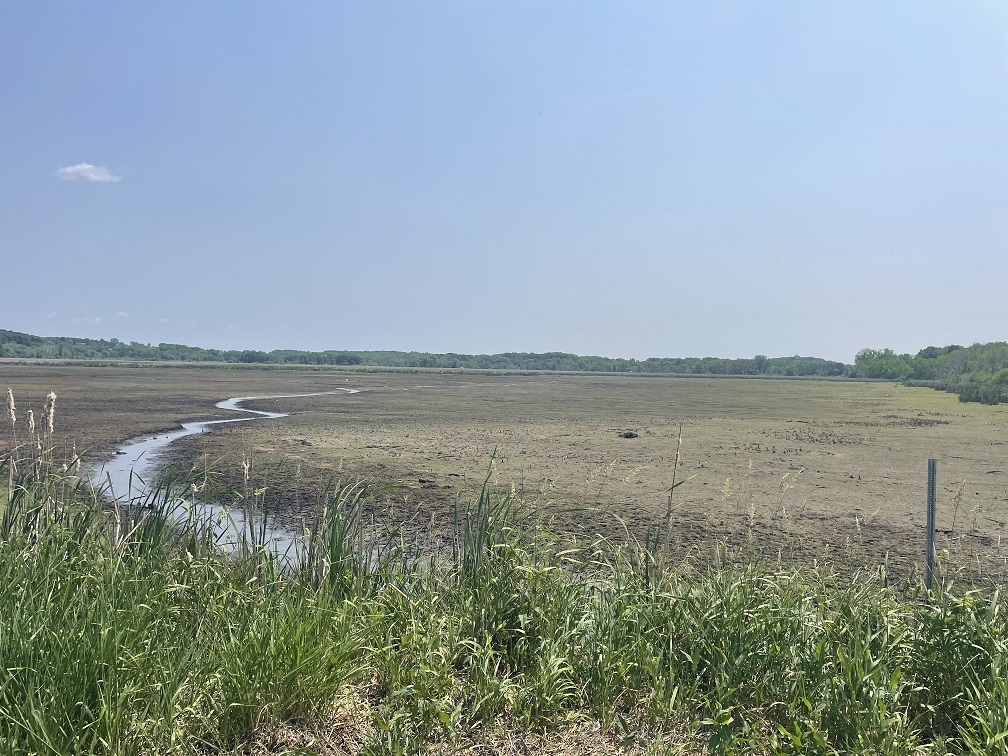
The bird response in spring 2023 was almost immediate. Mallard, widgeon, teal, great blue herons, egrets, and pelicans piled into the shallow marsh as the water receded, feasting on invertebrates and small fish. Shorebirds, including many black-necked stilts, foraged on the exposed mud.
Once dewatered, we kept the wetland dry through summer and well into fall. Past experience had shown that the new smartweed and barnyard grass seedlings would grow to 5-6’ tall and produce an abundance of seeds by September. Drought conditions throughout summer helped to dry out I-3, so that by late summer a person could easily walk across the wetland. The dense growth of smartweed and barnyard grass was also desired to help increase the intensity and spread of a fall prescribed fire.
Control of invasive cattails is difficult because of the challenge of working in wetlands and because of the need to remove old cattail thatch so native plants can establish. Research has demonstrated that cattails can be controlled by mowing followed by flooding over the cut stems. Cattails needs to have leaf tissue above the water to pump oxygen to roots and underground stems. Without that connection to the air, the plant will drown. However, the equipment needed to operate in wetlands is specialized and typically moves slowly, so this technique is difficult to employ at a large scale. Our intent with the I-3 experiment was to use fire rather than mowing to remove the cattail stems and then reflood over the stems. Using fire, we could consume hundreds of acres in a day. We planned to burn the wetland in mid- to late-fall after cattail senescence so that the cattails would not have an opportunity to regrow above the waterline before spring, hopeful resulting in greater stress or mortality. There was no research on this strategy and only a little speculation that it could be effective.
We struggled to get suitable weather for the burn. A southerly or easterly wind was needed to keep smoke off the adjacent state highway. We learned that southerly winds in the fall tended to be associated with humid or rainy weather. In mid-November, after a month of trials, we finally found a workable, though less than ideal, burn day. Conditions were humid enough that the fine grassy fuels we hoped would help increase fire intensity, would not burn. However, the cattail appeared to burn well. Cattail leaves burned entirely, but stems were more resistant and merely charred. It was unknown if these charred stems would still function to allow oxygen transport beneath the water line.
Following burning, we immediately began refilling the wetland. We replaced stop logs in a water control structure to be able to catch any precipitation that fell in the wetland’s watershed. We also had been pumping water into an adjacent wetland for over a month. We were able to gravity flow much of that water into I-3. And we continued pumping water into I-3 through December at a rate of up to 10,000 gallons per minute. Still, the water level rose almost imperceptibly, about ¼ inch per day.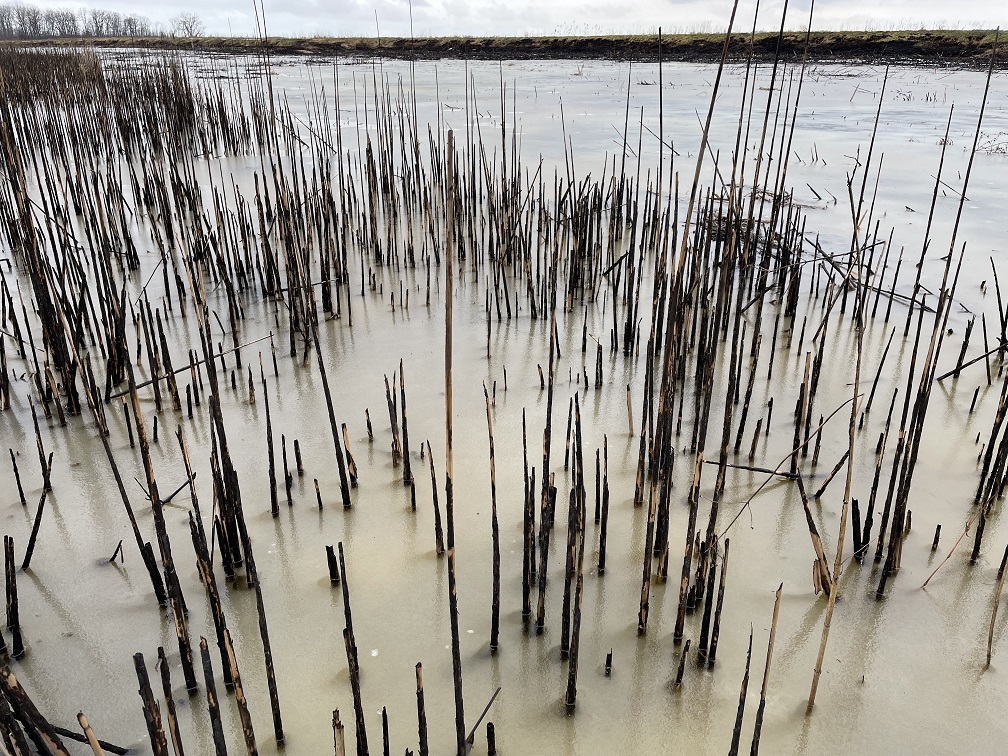
As the water returned so did the birds. Hundreds of dabbling ducks and sandhill cranes in fall, followed by several thousand ducks and geese in spring 2024. American coots, which historically were seen only infrequently on the wildlife area, became a common sight. People walking the dike dividing I-3 and the Bachhuber wetland stopped into the visitor center to ask why there were so many birds on I-3 and so few on Bachhuber. The drawdown worked to increase productivity.
Our success at cattail control was less clear. With the help of some timely rain and snowmelt, we were able to get I-3 almost fully flooded by early April. However, by late April, high elevation sites along highway 28, previously dominated by cattail, again began to green up with cattail shoots. The green wave continued to spread north and west nearly reclaiming the entirety of its past range. It appears that control may have been very limited. However, strips mowed in the cattail for a firebreak, where all stems and leaves were later submerged, showed the best control.
We learned a great deal from our experiment that we will carry forward as we continue to search for new ways to enhance the productivity of Horicon Marsh. In 2024, we will try a modified version of the I-3 experiment. We have already begun dewatering the I-1 and I-2 wetlands. This fall, with more options for wind direction, we will look for a day to burn when fire intensity hopefully can consume more of the cattail stems. And following burning, we will work to crush many of the remaining stems to help improve control. This management technique will continue to be cycled through the wetlands at Horicon, continually improved, to enhance the productivity of the marsh for wildlife and for the enjoyment of the visitors.
Article by Eric Kilburg, photos by the Wisconsin DNR
